Istanbul, Turkey, Monday, 18 June 2001
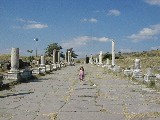
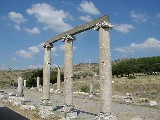 Saturday morning we visited the two principal archaeological sites of Bergama (ancient Pergamon or Pergamum). Our first stop was the Asclepieion, reached via this paved street lined with columns (which later much helped me to identify the site, at considerable distance, from the acropolis).
Saturday morning we visited the two principal archaeological sites of Bergama (ancient Pergamon or Pergamum). Our first stop was the Asclepieion, reached via this paved street lined with columns (which later much helped me to identify the site, at considerable distance, from the acropolis).
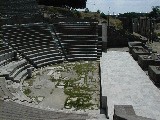
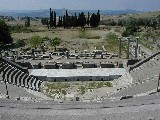
 Though the city had a large theater up on the acropolis from Hellenistic times (and nothing found anywhere around here was older than that, except some objets d'art likely brought in by early collectors), the Asclepieion boasted its own modest-sized theater, built facing south just outside the Ionic north stoa of the courtyard. Dramatic and musical performances here, according to a guidebook I purchased on the site, were conceived as a kind of therapy.
Though the city had a large theater up on the acropolis from Hellenistic times (and nothing found anywhere around here was older than that, except some objets d'art likely brought in by early collectors), the Asclepieion boasted its own modest-sized theater, built facing south just outside the Ionic north stoa of the courtyard. Dramatic and musical performances here, according to a guidebook I purchased on the site, were conceived as a kind of therapy.
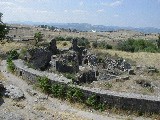
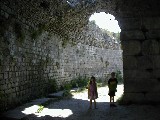
 The abaton or "therapy building" where the dream-cure took place was a round building.
The abaton or "therapy building" where the dream-cure took place was a round building.
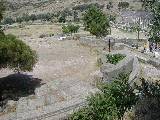
 Also round, and of similar date (second century A.D.), was this temple of Asclepius, modeled after the Pantheon in Rome. There was a round temple to Asclepius at Epidaurus as well--so he accounts for two out of three round temples that we have seen, and the third one (at Delphi) is unidentified as to dedication. At right, a tunnel or cryptoportico passes just barely underground from the sacred spring near the theater to the therapy building.
Also round, and of similar date (second century A.D.), was this temple of Asclepius, modeled after the Pantheon in Rome. There was a round temple to Asclepius at Epidaurus as well--so he accounts for two out of three round temples that we have seen, and the third one (at Delphi) is unidentified as to dedication. At right, a tunnel or cryptoportico passes just barely underground from the sacred spring near the theater to the therapy building.
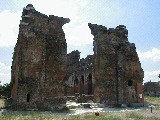 On our way to the acropolis we passed by this red brick edifice, originally a temple to the Egyption god Serapis, but later converted to a basilica for the Christian church here, one of the seven churches of Asia, represented as seven stars in the Apocalypse.
On our way to the acropolis we passed by this red brick edifice, originally a temple to the Egyption god Serapis, but later converted to a basilica for the Christian church here, one of the seven churches of Asia, represented as seven stars in the Apocalypse.
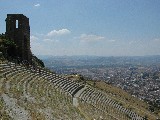
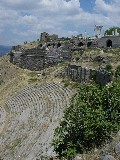 The large Hellenistic theater built on the side of the acropolis is both the highest and the steepest ancient theater I have seen. If, as seems likely, the steady breeze wafting up the slope from the orchestra to the cavea was a reliable phenomenon, it must have been an invaluable help to carry the voices of the actors.
The large Hellenistic theater built on the side of the acropolis is both the highest and the steepest ancient theater I have seen. If, as seems likely, the steady breeze wafting up the slope from the orchestra to the cavea was a reliable phenomenon, it must have been an invaluable help to carry the voices of the actors.
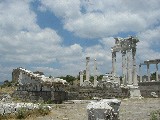
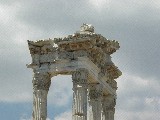
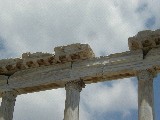 A temenos and temple dedicated to the emperor Trajan are the most spectacular re-erected ruins on the acropolis. Such sanctuaries, we learned, were more civic status objects than real centers of worship--the deification of the Caesars did not carry such conviction as that. The outer stoa's capitals (right) belong to none of the major orders, but are I think "Aeolic."
A temenos and temple dedicated to the emperor Trajan are the most spectacular re-erected ruins on the acropolis. Such sanctuaries, we learned, were more civic status objects than real centers of worship--the deification of the Caesars did not carry such conviction as that. The outer stoa's capitals (right) belong to none of the major orders, but are I think "Aeolic."

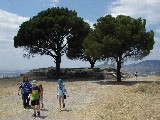 We ended our tour with a visit to the Great Altar, a separate freestanding structure used for sacrifices both to Zeus and Athena.
We ended our tour with a visit to the Great Altar, a separate freestanding structure used for sacrifices both to Zeus and Athena.
previous entry
next entry
main/ToC page


 Though the city had a large theater up on the acropolis from Hellenistic times (and nothing found anywhere around here was older than that, except some objets d'art likely brought in by early collectors), the Asclepieion boasted its own modest-sized theater, built facing south just outside the Ionic north stoa of the courtyard. Dramatic and musical performances here, according to a guidebook I purchased on the site, were conceived as a kind of therapy.
Though the city had a large theater up on the acropolis from Hellenistic times (and nothing found anywhere around here was older than that, except some objets d'art likely brought in by early collectors), the Asclepieion boasted its own modest-sized theater, built facing south just outside the Ionic north stoa of the courtyard. Dramatic and musical performances here, according to a guidebook I purchased on the site, were conceived as a kind of therapy.

 Saturday morning we visited the two principal archaeological sites of Bergama (ancient Pergamon or Pergamum). Our first stop was the Asclepieion, reached via this paved street lined with columns (which later much helped me to identify the site, at considerable distance, from the acropolis).
Saturday morning we visited the two principal archaeological sites of Bergama (ancient Pergamon or Pergamum). Our first stop was the Asclepieion, reached via this paved street lined with columns (which later much helped me to identify the site, at considerable distance, from the acropolis).











